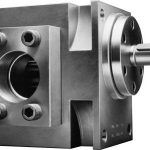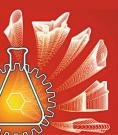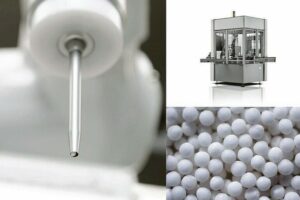For over two years now, mechanical equipment intended for use in potentially explosive atmospheres has also required certification. Despite this, there still seems to be some confusion about the correct choice of components for Atex applications. The aim of this article is therefore to help readers avoid potential pitfalls and clear the general fog that seems to be surrounding the design and selection of gear pumps for applications in Ex areas.
Andreas Bachmann
The fundamental aim of the Atex directives is to prevent the creation of potentially explosive atmospheres or, if this is not possible, to ensure that any equipment which is used in these zones has no ignition sources. The avoidance of potentially explosive atmospheres and the definition of Atex areas is the responsibility of the plant operator. The operator must perform a risk assessment of the plant in accordance with Atex 137 and divide it into zones and temperature classes according to the gases or dusts which can occur. By contrast, it is the responsibility of the supplier to ensure that any of his prod-ucts used in these zones and temperature classes are free of ignition sources. In accordance with Atex 95, suppliers must avoid all possible types of ignition source, including for example those arising due to excessively high surface temperatures, sparks, electro-static discharge, etc.
Selection of the temperature class
One important design aspect which is frequently misinterpreted is the selection of the required temperature class. The plant operator defines the zone and the temperature class on the basis of the risks present in the plant. In the process, the gases and dusts are classified in temperature classes ranging from T1 (ignition temperature >450 °C) to T6 (ignition temperature >85 °C). The higher the temperature class, the lower the ignition temperature of the media present in the zone – i.e. in a higher temperature class the maximum permitted surface temperature of the components used is lower. This means higher temperature classes also have more stringent requirements.
Practical implementation
Imagine the following example: in an Atex area a plant opera- tor uses ethylene, which has an ignition temperature of 425 °C. According to the definitions, this plant therefore needs to be operated with equipment which complies with temperature class T2 (ignition temperatures >300 °C). If the operator uses a three-phase AC motor in the same zone which is rated for temperature class T4 (ignition temperatures >135 °C), the pump he orders will often also be designed for the same temperature class (T4) – along the lines of “if it’s right for the motor, then it must be OK for the pump“. In principle, this is of course correct, as equipment designed for a higher class can always be used in lower temperature class applications. For example, three-phase AC motors are often certified for temperature class T4 as – providing a suitable design is used – the maximum permitted surface temperature for temperature class T4 is never reached. This naturally makes life easier for manufacturers and operators alike, as it allows a standard product to be used for all temperature classes from T1 to T4.
Unfortunately, however, in the case of a pump the situation is slightly more complicated. The permitted temperature class of a gear pump depends very much on the temperature of the material be-ing pumped. If in the above example the temperature of the material being pumped is 120 °C, this means that the pump is already no longer suitable for temperature class T4, as the maximum permitted temperature defined for this temperature class – namely 108 °C (zone 1, gases, continuous operation) – is already exceeded by the pumped material. This does not even take into account any additional temperature increases arising in and around the pump during operation. It is therefore not recommended to base decisions about the temperature class requirements in a specific zone on the temperature classes of other, existing components. The components installed in the zone are usually only marked with the maximum permitted temperature class, but not with the minimum required temperature class. Ultimately, the decision for or against a particular temperature class should depend solely on the gases and dusts which may be present in the zone.
Temperature of the pumped material
Gear pumps for Atex applications are generally designed according to the following equation:
Tfluid + DTpump = Tmax # Tmax.perm. = Tignit. – DTsafety
where Tfluid is the fluid temperature on entry into the pump, DTpump is the temperature increase in and around the pump (safety allowance), Tmax is the maximum surface temperature which can occur on the pump, Tmax.perm. is the maximum permissible surface temperature of the pump, Tignit. is the minimum ignition temperature for the defined temperature class and DTsafety is the safety margin (in accordance with the directive) depending on the zone, operating time and type of potentially explosive atmosphere (gas, dust).
Due to the inclusion of safety margins and expected temperature increases, the maximum permitted temperature of the material being pumped may be significantly less than the effective ignition temperature of the atmosphere. Let us again consider the example of ethylene with an ignition temperature of 425 °C. As the minimum required ignition temperature for class T1 is 450 °C, the next higher temperature class T2 (>300 °C) needs to be chosen for ethylene. According to the definitions, the maximum surface temperature for temperature class T2 is 240 °C (zone 1, gases, continuous operation). If a gear pump with a magnetic coupling is ordered for this temperature class without any further details being specified, the maximum temperature for the material being pumped is approximately 160 °C, as temperature increases of up to 80 °C can arise within the magnetic coupling. This temperature increase is a maximum value which does not make allowances for application data like pressures, speeds or the viscosity of the pumped material. Ultimately, this means that the permissible temperature of the pumped material is 265 K below the effective ignition temperature of the surroundings. Of course, there is often a lack of understanding for the magnitude of this value among operators. The reason for this huge temperature difference lies in the way the temperature classes are handled and the standardised safety factors which enable fast configuration and planning for non-critical applications.
Carefully adapted
If the initial design – like the one described in the example above – is unsatisfactory and all relevant operating data is available, then the maximum permitted temperature of the material being pumped can be increased by means of the following measures:
- Instead of a fixed classification based on temperature classes, the pump can also be certified for a defined temperature (e.g. 3 G T = 400 °C).
- Through a careful choice of dimensions, materials and components (e.g. magnetic couplings with a double containment shell), it is possible to minimise the potential temperature increases in and around the pump, and this in turn means that the required safety allowances can be minimised.
In the case of the above example, the maximum permitted temperature of the material being pumped could then theoretically be increased to around 300 °C. However, this type of optimisation is only feasible if the operator of the plant and the manufacturer of the pump sit down together to discuss the effective process data and the technical possibilities in detail.
Hall 8.0, Booth R10
cpp 403
All pumps available with Atex certification

cav: Today, the regulations concerning explosion protection in industrial production plants are harmonised Europe-wide. Which components in the Maag Pump Systems Textron product range are suitable for Atex applications?
Bachmann: We are able to offer all gear pumps as Atex equipment in categories 2G/2D and 3G/3D for use in zones 1 and 2. As a manufacturer of pump systems, we noticed that there are frequent misunderstandings regarding the choice of suitable components for these environments. Our long-term experience in chemical, industrial and plastics applications make us an ideal partner for all Atex topics. The use of the optimum material combinations, tolerance classes and geometries customised from a modular system enables Maag to meet tough demands like Atex compliance. When it comes pumps for low suction pressures, highly viscous or corrosive media, high differential pres-sures and high temperatures, Maag is ready for the challenge.
cav: How important is Ex proofing at Achema 2006?
Bachmann: Ex proofing is elementary for component manufacturers in the process industry. Since the Atex regulations are compulsory, producers have to make sure that as many of their products are Atex qualified as possible. Nevertheless, Atex is not our main topic at the exhibition, because today it is a standard that simply has to be met. We set great store by offering Atex compliance with all new prod-ucts, such as our new magnetic coupling on show at Achema. This innovative seal is a low-price alternative to our existing coupling. The demand for gear pumps with a magnetic coupling is rising continuously as a result of increased environmental awareness. We will present our new coupling, which can also be used in price-sensitive applications as a substitute for mechanical seals, in response to this market development.
cav: Which other products will be showcased by Maag between May 15th and 19th in Frankfurt?
Bachmann: Another main focus of our exhibition stand will be products for polymer processes. As market leader in the polymer systems sector, we will be demonstrating an enhanced version of vispac, our proven sealing system. It represents a combination of dynamic and gland sealing that is used as a system in gear pumps for high-viscosity polymer melts. The most important advantages of this product improvement are easier handling and increased process reliability. Our new filtration technique for polymer processes will be a further highlight. It unites the benefits of filtration with screen changers with large-area filtration. Our steadily growing worldwide production, sales and service network will also be a topic at our Achema presentation. Everyone interested in learning more about these latest developments is cordially invited to visit our booth.
More information on gear pumps
Pump calculator
Atex-guideline
Achema 2006
Share:










